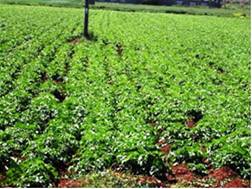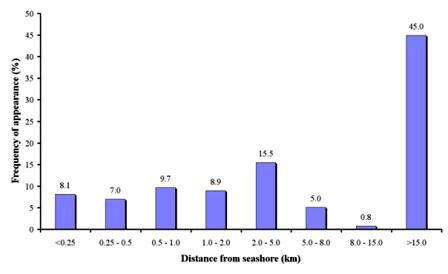Distance of low elevation lands from the sea shore
This indicator is mainly used to assess the effect of water quality on soil salinization risk. The shorter the distance of a site from the nearby seashore, the greater the risk of soil salinization is expected. Soil texture and hydromorphic conditions are greatly related to the distance from the seashore and of course the location in relation to riverbed. Soils located in a short distance and far from the riverbed are usually fine-textured and poorly drained with a permanent ground water table fluctuating between 30-150 cm from the soil surface. Such soils under semi-arid and arid climatic conditions are vulnerable to salininzation and desertification. On the contrary, soils located far from the coast and from the riverbed are usually well drained or some what poorly drained of medium to moderately fine texture. Such soils are lees vulnerable too salinization and desertification under the same climatic conditions (Fig 86).


Fig. 86. Examples of soils located in the same alluvial plain but in different distance from the seashore (left photo-very poorly, fine-textured soil, highly affected from salinization, located 750 m from the seashore; right photo-well drained, moderately fine textured soil, free of salts, located 4200 m from the seashore
The distance form the shortest seashore of study field sites in which the main process of desertification was soil salinization has been measured using topographic maps, aerial photos, etc. The following classes of distance from seashore (D) have been distinguished: (a) D<0.25 km, (b) D=0.25-1 km, (c) D=1-2 km, (d) D=2-5 km, (e) D=5-8 km, (f) D=8-15 km and (g) D>15 km.
Data for this indicator were collected in 258 study field sites, corresponding to 5 study sites. The dominant class of distance from the seashore was greater than 15 km, covering 45% of the study field sites. Such field sites have been located in all cases of the study sites of Boteti Area-Botswana, Djanybek-Russia, and Novij Saratov-Russia (Fig. 87). The next important class of distance from the seashore was 2-5 km, covering 15.5% of the study field sites and corresponding to the study sites of Nestos Basin Maggana-Greece, and Crete-Greece. The other classes of distance from the seashore shows an almost uniform distribution with frequency of appearance less than 10%, covering all the distances form the seashore (Fig. 87).

Fig. 87. Distribution distance from seashore classes of the study field sites related to soil salinization